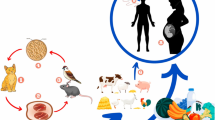Abstract
The present study investigated whether people working closely with animals were at higher risk of getting infected with Blastocystis hominis. The prevalence of the parasite was determined in two population groups, i.e., animal handlers and normal healthy individuals who did not work with animals. In all, 105 stool samples were collected from animal handlers from 2 local research institutions, a local zoo, and a local abattoir and 163 stool samples were collected from normal healthy individuals residing in high-rise flats in the city. The in vitro culture method used in the study detected that 41% of 105 animal handlers and 17% of 163 flat-dwellers in the city were positive for Blastocystis. This statistically significant finding (P=0.0000313) shows that people who work closely with animals do stand at risk of acquiring Blastocystis infection.
Similar content being viewed by others
Author information
Authors and Affiliations
Additional information
Received: 12 February 1999 / Accepted: 27 February 1999
Rights and permissions
About this article
Cite this article
Salim, H., Kumar, G., Vellayan, S. et al. Blastocystis in animal handlers. Parasitol Res 85, 1032–1033 (1999). https://doi.org/10.1007/s004360050677
Issue Date:
DOI: https://doi.org/10.1007/s004360050677




